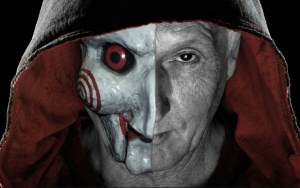Metro In Focus: the science behind why we watch horror movies.
 By Richard Crouse – Metro In Focus
By Richard Crouse – Metro In Focus
In the movie Hitchcock, the master of suspense, played by Anthony Hopkins, says, “Audiences want to be shocked — they want something different.” He’s referring to the lurid horrors of his ground breaking 1960 film Psycho but he could have been talking about any number of frights available on screens this month.
Trends come and go but one thing is for sure, audiences will always line up to get scared at the movies. Whether it is the time loop terrors of Happy Death Day or the return of Jigsaw, the evil mastermind from the Saw series, there is no shortage of things that go bump in the night at the movies this Halloween.
But why do we pay to be scared? Isn’t that counterintuitive?
Scientists tell us that we like the rush of adrenalin that comes from watching Leatherface chase victims, chainsaw roaring.
That jolt of fear makes the heart race and releases a hormone called dopamine that’s also associated with pleasure. Science journalist Jeff Wise called the experience of extreme movie fear “the biological equivalent of opening the throttle.”
A Saturday matinee screening of Paranormal Activity was the first and only time I ever heard anyone actually scream in a theatre.
I don’t mean a quiet whimper followed by an embarrassed laugh or a frightened little squeal. No, I mean a full-on, open throated howl of terror. But the woman didn’t run from the theatre. She stayed and enjoyed the rest of the film, so she must have liked the cathartic release of tension the scream gave her.
Legendary filmmaker and showman William Castle took full advantage of the audience’s love of shocks.
The advertising campaign for Macabre, his 1958 schlockfest about a doctor’s daughter who’s been buried alive, boasted that every ticket purchaser would receive a $1,000 insurance policy against “death by fright” issued by Lloyds of London.
Those brave enough to make it through to the end credits were rewarded with a badge that read, “I’m no chicken. I saw Macabre.” The gimmicks worked, drawing thrill-seeking crowds who spent an astronomical $5 million (roughly $42,505,633.80 in today’s dollars) at the box office to see a movie that cost Castle a paltry $90,000 to produce.
Alfred Hitchcock knew how to scare the wits out of people. The shower scene in Psycho, for example, is a benchmark in cinematic fear. If he had any doubts about the effectiveness of that sequence they must have been put to bed when he received an angry letter from a father whose daughter stopped bathing after seeing the bathtub murder scene in Les Diaboliques and then, more distressingly, refused to shower after seeing Psycho.
Hitch’s response to the concerned dad? “Send her to the dry cleaners.”
The director was always quick with a line, but when it got down to the business of terrifying audiences he summed up the appeal of the scary movie in one brief sentence: “People like to be scared when they feel safe.”
But what scares the people who scare us?
Guillermo del Toro, director of Pan’s Labyrinth and the upcoming The Shape of Water, says, “I love monsters the way people worship holy images,” but it isn’t Frankenstein or Dracula that gives him the willies. “Politicians,” he said recently, “they’re the scariest thing there is right now.”
